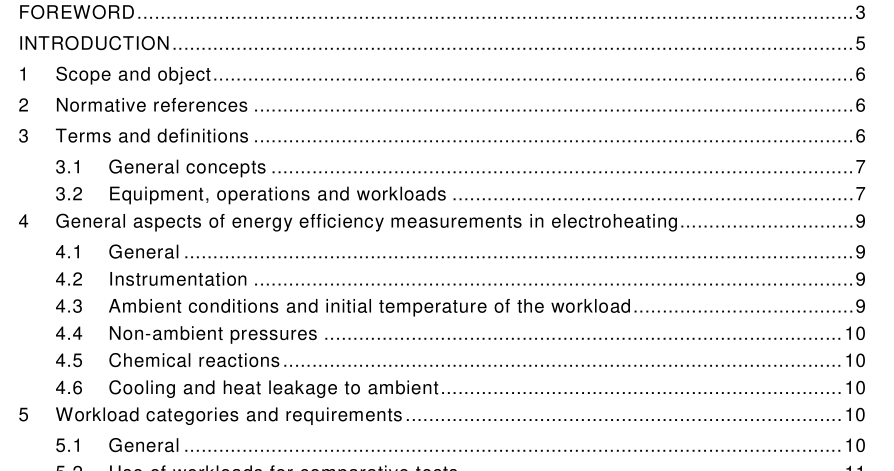IEC TS 62796-2013 pdf Energy efficiency in electroheating installations

3.2.4 efficiency, <of an electroheating installation> ratio of the usable enthalpy increase in the workload to the electric energy supplied to it at the location of the equipment, during a cycle of batch operation or stationary operation during a suitable time period for measurements [SOURCE: IEC 60050-841 :2004, 841 -22-70, modified – Enthalpy increase in the workload is specified instead of useful energy, and measurement time limits have been added.] 3.2.5 performance, <of an electroheating installation> degree to which the intended functions, including energy or power consumption and output as well as the result of the treatment of the workload are accomplished 3.2.6 end product quality degree to which a set of inherent characteristics of a processed workload fulfils requirements 3.2.7 power factor under periodic conditions, ratio of the absolute value of the active power P to the apparent power S Note 1 to entry: This is applied to the supply network under normal operation. [SOURCE: IEC/TS 62257-1 2-1 :2007 [2], 3.4, modified – Note 1 to entry has been added.] 3.2.8 cold start-up process by which the equipment is energised into hot standby operation from the cold state, including all other start-up operations which enable the equipment to run under normal operation Note 1 to entry: This mode of operation applies to cases where there is a significant energy consumption needed for obtaining a state of the equipment allowing the actual processing of the workload, see 6.1 .
7.2 Measurement of electric-only conversion efficiency The input electric power and power factor and the electric output power flow are measured and reported under normal operation with equal workload specification. The workload is then either a normal, a dummy or a performance test workload. All measurements of the electric energy consumption shall reflect specific consumption by defined parts of the installation during a defined time period or a specified operation. The following shall be reported, if applicable: a) The energy consumption of a batch type installation during one cycle; this may be measured and averaged over a defined number of cycles. The number of cycles and variation of energy consumption shall be recorded in the measurement report. b) The energy consumption of equipment for continuous operation during processing of a defined amount of workload. c) The energy consumption of the equipment over a complete production cycle – for example from morning to evening. If the final frequency conversion is by a standardised component, its manufacturer data may be used. Any ancillary electric power needed for energising a component or assembly for the final frequency conversion is included in the electric input from the supply network. The electric power consumption by any cooling devices is not included, neither of any other control circuit. If there is an external voltage transformation from the external network supplying the plant to a special voltage which is fed into the equipment, these transformation losses are not included. 7.3 Measurement of electroheating energy consumption and efficiency In addition to the specifications in Clause 5, the power consumption of the mechanical accessories needed for the operation and use of the electroheating equipment shall be considered separately. Any ancillary cooling or preheating equipment not being a part of the equipment under test is also considered as separate in Clause 8.
- ISO IEC 27050-4-2021 pdf Information technology — Electronic discovery — Part 4: Technical readiness
- ISO IEC 27036-1-2021 pdf Cybersecurity — Supplier relationships — Part 1: Overview and concepts
- ISO IEC 27013-2021 pdf Information security, cybersecurity and privacy protection — Guidance on the integrated implementation of ISO/IEC 27001 and ISO/IEC 20000-1
- ISO IEC 26580-2021 pdf Software and systems engineering — Methods and tools for the feature- based approach to software and systems product line engineering
- ISO IEC 24735-2021 pdf Information technology — Office equipment — Method for measuring digital copying productivity
- ISO IEC 24711-2021 pdf Information technology — Office equipment — Method for the determination of ink cartridge yield for colour inkjet printers and multi- function devices that contain printer components
- ISO IEC 23544-2021 pdf Information Technology — Data centres — Application Platform Energy Effectiveness (APEE)
- ISO IEC 23510-2021 pdf Information technology — 3D printing and scanning — Framework for an Additive Manufacturing Service Platform (AMSP)
- ISO IEC 23127-1-2021 pdf Information technology — Learning, education, and training — Metadata for facilitators of online learning — Part 1: Framework
- ISO IEC 23126-2021 pdf Information technology for learning, education and training — Ubiquitous learning resource organization and description framework
- IEC TR 61188-8-2021 pdf Circuit boards and circuit board assemblies – Design and use – Part 8: 3D shape data for CAD component library
- IEC 62546-2009 pdf High Definition (HD) recording link guidelines
- IEC 62810-2015 pdf Cylindrical cavity method to measure the complex permittivity of low-loss dielectric rods
- ISO IEC 27013-2021 pdf Information security, cybersecurity and privacy protection — Guidance on the integrated implementation of ISO/IEC 27001 and ISO/IEC 20000-1
- IEC TR 62834-2013 pdf IEC nanoelectronics standardization roadmap
- BS ISO IEC 15420-2009 pdf Information technology一 Automatic identification and data capture techniques EAN/UPC bar code symbology specification
- BS ISO IEC 19762.5-2008 pdf Information technology一 Automatic identification and data capture (AIDC) techniques – Harmonized vocabulary Part 5: Locating systems
- BS IEC 60860-2014 pdf Radiation protection instrumentation一 Warning equipment for criticality accidents
- ISO IEC 24735-2021 pdf Information technology — Office equipment — Method for measuring digital copying productivity
- ISO IEC 24711-2021 pdf Information technology — Office equipment — Method for the determination of ink cartridge yield for colour inkjet printers and multi- function devices that contain printer components